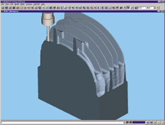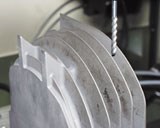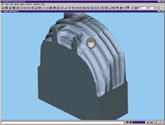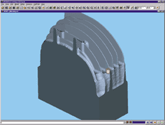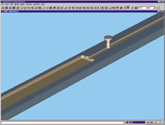The Case For Verifying And Optimizing Tool Paths
Two very different shops illustrate the potential value of software that works between the CAM software and the CNC.
Share









Takumi USA
Featured Content
View More
Hwacheon Machinery America, Inc.
Featured Content
View MoreShops wishing to reduce their costs and increase efficiency often invest heavily in automation equipment and high-speed machinery. But what many shops fail to realize is that the savings they are looking for don't necessarily have to come from hardware used on the shop floor ...they can also come from software used in the office. A small amount of time spent at the computer to prepare NC tool paths properly and thoroughly before sending them to the shop can deliver big savings at the machine. One tool developed specifically for this preparation work is NC verification software.
Many shops now rely on verification software to prove-out their programs. The software can ensure the first part is a good part, so no operator has to stand by the machine to watch the first part run. Thus, dry runs and cutting test parts become a thing of the past.
In addition, verification software can offer automatic feed rate optimization features that can deliver several benefits. Cycle time, part quality and tool life can all improve as a result of more refined control over feed rate. A program with "optimized" feed rates may also make it easier for the operator to turn attention away from the machine.
Verification
NC verification software enables a programmer to check the integrity of tool path files before sending them to the shop floor to begin cutting metal. Not only does this reduce the possibility of an expensive machine crash, it also saves re-work during the prove-out cycle, and it often eliminates the physical prove-out process altogether. This can mean big savings in terms of materials, labor costs and machine hours, as various shops have discovered.
One such shop is Contour Aerospace (Everett, Washington), a manufacturer of components and subassemblies for aerospace applications. Before adding verification software to the production process, the manufacturing team at Contour had to cut a test part, lay it out and perform an inspection. If there were any problems, the shop would have to correct the NC program, cut another test part and re-inspect it before proceeding with production.
"On our large parts, this was very time consuming," says NC programming manager Dan Hornung. The company makes wing spars in the range of 20 to 40 feet long, and the freedom to prove out jobs for parts like these in the computer instead of in real life offers an important advantage.
A maker of big parts of a very different sort is Delaware Machinery & Tool (Muncie, Indiana). Delaware Machinery specializes in designing and building large die-cast molds used to make engine blocks and transmission cases. The company also has a reputation for using the latest manufacturing software technology. The first transmission dies for Ford, GM and Chrysler to be designed and built using CAD were provided by Delaware.
Today the shop's software toolkit includes verification software. "Checking tool paths at the computer has enabled us to reduce the number of shopfloor prove-outs and reduce redundancy," says CAM manager Dennis Main.
The software also helps streamline the programming process. It offers the capability to check for gouges by embedding the design model inside the virtual stock model. When the cutting tool contacts the design model within a user-specified tolerance range, an error is reported.
CGTech's Vericut is the software both shops use. Delaware's Mr. Main says, "After posting our code, we're able to run the G-code for an electrode job through Vericut and electronically check the cut-under for spark gap. We can intentionally cut the part to 0.020 ‘under,' then check the as-machined model against the CAD model to make sure that all areas have been cut into the graphite blank . . . and to verify that no areas of the electrode will cause an over-burn." This feature helps Delaware meet tight machining tolerance requirements.
Contour's Mr. Hornung sees similar advantages. "The constant gouge protection feature really started to pay off around the time we began manufacturing parts for the Boeing 777...because that's when the customer went to solid design models."
Optimization
For Delaware, it was when company director of engineering Dan Swartz sent an engineer to a verification software update course that the shop learned about feed rate optimization functionality available as an add-on module for the same software. That engineer returned excited about what he saw as a way to dramatically improve the company's machining process.
With the optimization function, the software reads NC tool path files and automatically adjusts the existing feed rates to more appropriate values based on cutting conditions and tool capacity. Machining with feed rates tailored to each individual cut increases machine tool efficiency, so parts take less time to cut. In machining graphite electrodes, Delaware's team calculated that feed rate optimization saves 30 percent in machine run time. "We've seen 45 percent in some cases," says Mr. Swartz.
Feed rate optimization works by reading the NC tool path file (G-code or APT format) and dividing motion into a number of smaller segments. Based on the amount of material removed in each segment, the software assigns the best feed rate for the cutting condition encountered. It then outputs a new tool path that is identical except for the feed rate setting. The tool path trajectory is unchanged.
This solution could be said to offer the best of both worlds. On one hand, the optimization is automatic and works before the NC program is ever loaded on the machine. On the other hand, it draws on the expertise of the NC programmer and machinist in the way it responds to specific cutting conditions. Users input ideal feed rates for a number of pre-determined machining conditions. Factors include machine tool capabilities such as horsepower, spindle type, rapid traverse speed, coolant and other characteristics; plus fixture and clamp rigidity; as well as cutting tool characteristics including material, design, length and number of teeth. These factors suggest the chip thickness, volume removal rate, entry feed rate and other parameters used to calculate the optimum feed rate for each segment of the cut.
Typically, different types of optimization techniques are best suited for different materials or machining processes. During planar roughing of aluminum structural components, for example, material is removed at a constant axial depth, but the radial width of cut varies greatly throughout the cycle. In an operation such as this, maintaining a constant volume removal rate keeps the cutter at its maximum rate of advance into material for the varying cut width. Employing the same information used to verify the tool path, the software is able to determine the amount of material removed in each toolpath segment. The software then assigns the appropriate feed rate based on information supplied by the NC programmer and/or machine tool operator.
A very different operation is semi-finishing or finishing a tool steel mold cavity. Here, the cutting is typically characterized by widely varying chip loads as the tool profiles over the contours of the workpiece. In order to achieve a constant chip load, feed rates are optimized based on the maximum chip thickness for each cut segment. The software takes into account where the material meets the cutter along its profile, and it adjusts the feed rate to keep chip thickness constant. This is especially critical when cutting with a ball end mill, or when contouring a surface with a small step-over. The feed rates continually change over the course of the cut in order to maintain the constant maximum chip thickness. The result is an improvement in both tool life and surface finish.
Engineers at Contour Aerospace were quick to see the benefits of machining with optimized tool path files. Mr. Hornung says, "We see a big savings in areas like pocketing routines." The optimization let the shop abandon a preference for conservative feed rates, he says. In addition, "Optimized feed rates provide a more constant spindle load—usually around 80 to 90 percent—and eliminate our reliance on manual feed rate changes to cut the pockets correctly."
The rear wing spars and ribs for the Gulfstream IV corporate jet are typical of the parts Contour manufactures. The company uses three-spindle, three-axis gantry machines with 30-hp spindles and 2-inch carbide insert cutters to rough the parts. The stock billet for the rear spar measured 480 inches and weighed 2,500 pounds before machining, but with 95 percent of the material removed during machining, the finished part weighed 128 pounds.
"On parts like this, we use the software to maintain a constant volume removal rate—in this case around 85 cubic inches per minute—to keep the spindle load where we want it," says Mr. Hornung. By optimizing the roughing passes on the part, Contour cut about 25 percent from the machining time. "That equates to saving thousands of dollars a year," he says.
Process Improvements
Software optimization not only speeds machining, but also helps make the entire manufacturing environment more efficient. Before optimizing tool paths, Delaware's graphite electrode machining department had not been able to take full advantage of its high speed milling machines, even those equipped with robust look-ahead capability. According to Mr. Main, those machines were "a bit ineffective when machining intricate or involved shapes." They tended to slow down in areas where the axes changed direction and not slow down in areas of heavy material removal, so manual feed rate adjustment at the machine was necessary. This required the shop to assign one operator per machine on each job. If the operator needed to leave the machine even for a short time, he had to "dial down" the feed rate until he returned.
The optimization software changed that. Now, when running optimized programs, operators are able to run two or more machines at a time. "It's really reduced our costs and increased our manpower productivity," says Mr. Swartz.
It can make for a "smarter" process, too. For example, Contour Aerospace's machines have a variety of controls. "The great thing about the optimization software is that it takes the particular control into account, so we're running the most efficient feeds for each individual machine/control combination," says Mr. Hornung.
In addition, most shops have at least one "resident expert" who knows the best feed rates to use for different machines, cutters, cutting conditions and types of material. Storing this information in the software creates a "machining database" available to everyone in the shop. This library of information can help the shop achieve more consistent machining results between different operators, machines and shifts. "We see a lot more consistency and all around better part quality with the optimized feed rates," says Delaware Machinery's Mr. Main.
In fact, the improvement in part quality is a major benefit to mold maker Delaware, because this shop is accustomed to devoting significant labor hours to polishing. With the optimization software, the shop has been able to eliminate this labor-intensive process. Driving the machine with a more constant chip load results in a smoother machined surface.
The tool often comes away looking better, too. "With the improved feed rates and constant chip load, our cutters are lasting longer and we're spending less time changing out tooling," says Mr. Main.
Contour Aerospace's Mr. Hornung agrees. By running optimized feed rates on the machine, he says, the shop is able to more accurately project how long tooling will last. Contour stops production less often to replace worn inserts.
Different Thinking
A good example of how Delaware Machinery benefits from optimizing tool paths came from a recent job for a small engine block containing many small cooling fins. "This isn't the type of job we necessarily specialize in, but we've done these before," says Mr. Swartz. "In the past, we really needed to be careful when machining and handling these electrodes because the fins can be broken easily." But this time, due to the more constant chip load and cutting pressure resulting from optimization, the shop had no problems with breakage. "The capability is helping us gain a new type of business," he says.
Contour Aerospace is also seeing improved part quality from the more targeted feed rates. "Because the feed rates are pre-determined by the optimization software, they run the same way each time, regardless of who is at the machine," says Mr. Hornung. "This supports our quality-based variability reduction and lean manufacturing efforts."
And the move to computer-optimized feed rates as an alternative to overriding feed rate manually has generally been accepted by programmers, operators and management alike, he says. "At first, some of them thought we were nuts. They're used to seeing the feed rate needle stay somewhat constant when we start cutting a part, usually around 80 ipm. With the optimized programs, the needle is jumping up and down from the very beginning." It was only after seeing the results that most were convinced, he says.
About the author: Jeff Werner is marketing communications manager for CGTech of Irvine, California.
Related Content
ERP Provides Smooth Pathway to Data Security
With the CMMC data security standards looming, machine shops serving the defense industry can turn to ERP to keep business moving.
Read MoreTips for Designing CNC Programs That Help Operators
The way a G-code program is formatted directly affects the productivity of the CNC people who use them. Design CNC programs that make CNC setup people and operators’ jobs easier.
Read MoreContinuous Improvement and New Functionality Are the Name of the Game
Mastercam 2025 incorporates big advancements and small — all based on customer feedback and the company’s commitment to keeping its signature product best in class.
Read MoreCan AI Replace Programmers? Writers Face a Similar Question
The answer is the same in both cases. Artificial intelligence performs sophisticated tasks, but falls short of delivering on the fullness of what the work entails.
Read MoreRead Next
Building Out a Foundation for Student Machinists
Autodesk and Haas have teamed up to produce an introductory course for students that covers the basics of CAD, CAM and CNC while providing them with a portfolio part.
Read More5 Rules of Thumb for Buying CNC Machine Tools
Use these tips to carefully plan your machine tool purchases and to avoid regretting your decision later.
Read MoreRegistration Now Open for the Precision Machining Technology Show (PMTS) 2025
The precision machining industry’s premier event returns to Cleveland, OH, April 1-3.
Read More
























